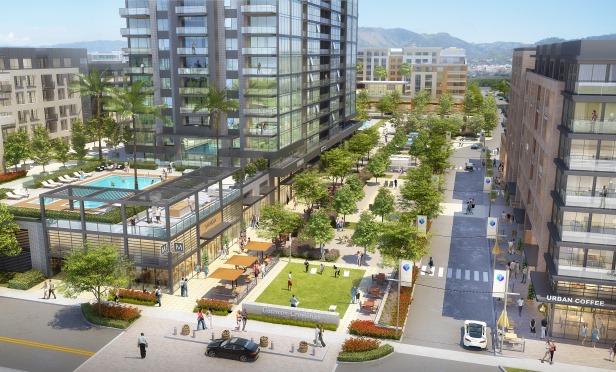 Gateway Crossings will provide 1,565 homes, a hotel, two parks and 45,000 square feet of retail.
Gateway Crossings will provide 1,565 homes, a hotel, two parks and 45,000 square feet of retail.
CUPERTINO, CA—No longer confined to standalone retail, behemoth office campuses or multifamily without access to conveniences, many developments are going the mixed-use route. And, with Santa Clara city council's recent approval of Hunter Storm's proposed Gateway Crossings project, a mixed-use transit-oriented development, and Verizon's recent commitment to lease 643,000 square feet for a new technology hub at Coleman Highline, the stage is now set for Hunter Storm to fulfill its vision of a transit village next to the San Jose International Airport. Groundbreaking is planned to take place in fall 2019, with completion slated for 2021.
Gateway Crossings will provide 1,565 homes directly adjacent to Cupertino-based Hunter Properties' new tech office campus. In addition to residential, Gateway Crossings will feature a hotel with 225 rooms, two parks with 2.5 acres of public space and 45,000 square feet of retail.
Coleman Highline, a project with 1.75 million square feet, will support more than 8,000 employees and include an additional 7,500 square feet of retail with a public market plus another hotel with 175 rooms next to Avaya Stadium. The campus will be built in phases, with Verizon co-developing its spaces.
Two major tenants have already taken the majority of space in the office campus. Verizon Media recently announced it was taking 643,990 square feet for its Bay Area tech hub and Roku Inc. leased 730,000 square feet last summer for its new corporate headquarters.
"After many years of planning and working closely with the local community, we're ecstatic that we're finally able to bring these two projects to market in tandem and have the once-in-a-lifetime opportunity to create a convenient, transit-oriented, live-work community for thousands of people," says Deke Hunter, managing partner and president of Hunter Properties. "These projects will allow employees the opportunity to work, shop and play where they live, while the robust transit connections will make this a convenient destination for those from around the Bay Area and beyond."
Straddling the border of the cities of San Jose and Santa Clara, the village will be located on Coleman Avenue and next to the Santa Clara Transit Center currently served by Caltrain, Altamont Corridor Express, Valley Transit Authority and the future site of a new BART station.
The Verizon tech hub will include a 2,250-square-foot welcome pavilion and more than 45,000 square feet of workplace amenities such as a fitness center and cafeteria. The project is designed by Gensler.
"We're grateful that we have the opportunity to deliver a truly mixed-use project of office, residential and retail together in one package after many years of hard work," Hunter tells GlobeSt.com. "We are excited that these two symbiotic projects will create a village for living, working and playing for everyone's benefit."
Cupertino's private sector is dominated by high-tech companies and numerous small businesses, according to the city of Cupertino. The city serves as a center for research and development, with virtually no manufacturing taking place here because of the high cost of land. Highly skilled employees work and live in the Cupertino area due to its moderate size and balanced mix of high technology firms, retail centers, open space, quality schools and residential areas.
© Touchpoint Markets, All Rights Reserved. Request academic re-use from www.copyright.com. All other uses, submit a request to [email protected]. For more inforrmation visit Asset & Logo Licensing.







